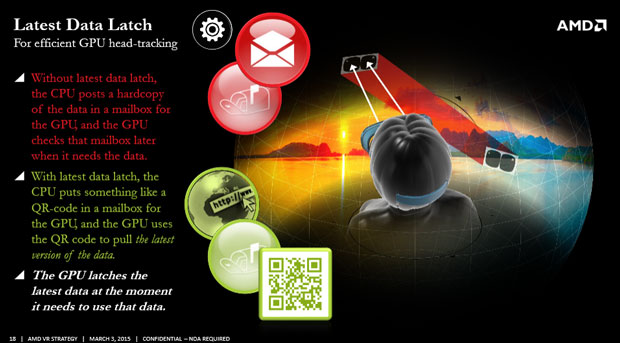AMD Enters Virtual Reality Fray With LiquidVR SDK At GDC
The Game Developer Conference in San Francisco is underway and virtual reality (VR) is getting plenty of love from big names in gaming. One of them is AMD, which announced today its LiquidVR SDK that will help developers customize VR content for AMD hardware.

“The upcoming LiquidVR SDK makes a number of technologies available which help address obstacles in content, comfort and compatibility that together take the industry a major step closer to true, life-like presence across all VR games, applications, and experiences,” AMD said in a statement.

The winners in the virtual reality war are going to be those who can achieve the strongest sense of “presence.” That’s the feeling you have of actually being in the virtual world, and it’s usually determined by the speed with which the virtual world (within your view) updates as you move. If you physically turn your head but there’s even a short pause before your view updates in the virtual world, the sense of actually being in the world is lost.

Oculus is one of the VR companies that will be working with AMD’s LiquidVR SDK and it seems to like what it’s seen so far. “Achieving presence in a virtual world continues to be one of the most important elements to delivering amazing VR,” Brendan Iribe, CEO of Oculus said in a statement. “We’re excited to have AMD working with us on their part of the latency equation, introducing support for new features like asynchronous timewarp and late latching, and compatibility improvements that ensure that Oculus’ users have a great experience on AMD hardware."

AMD highlighted several features of the LiquidVR SDK at the conference, including Affinity Multi-GPU, which lets multiple GPUs work together in VR applications (important for framerate improvements) and asynchronous shaders for Hardware-Accelerated Time-Warp, which is meant to improve motion-to-photon latency, or your sense of presence.

“The upcoming LiquidVR SDK makes a number of technologies available which help address obstacles in content, comfort and compatibility that together take the industry a major step closer to true, life-like presence across all VR games, applications, and experiences,” AMD said in a statement.

The winners in the virtual reality war are going to be those who can achieve the strongest sense of “presence.” That’s the feeling you have of actually being in the virtual world, and it’s usually determined by the speed with which the virtual world (within your view) updates as you move. If you physically turn your head but there’s even a short pause before your view updates in the virtual world, the sense of actually being in the world is lost.

Oculus is one of the VR companies that will be working with AMD’s LiquidVR SDK and it seems to like what it’s seen so far. “Achieving presence in a virtual world continues to be one of the most important elements to delivering amazing VR,” Brendan Iribe, CEO of Oculus said in a statement. “We’re excited to have AMD working with us on their part of the latency equation, introducing support for new features like asynchronous timewarp and late latching, and compatibility improvements that ensure that Oculus’ users have a great experience on AMD hardware."

AMD is working with Oculus as it produces its VR software/hardware package.
AMD highlighted several features of the LiquidVR SDK at the conference, including Affinity Multi-GPU, which lets multiple GPUs work together in VR applications (important for framerate improvements) and asynchronous shaders for Hardware-Accelerated Time-Warp, which is meant to improve motion-to-photon latency, or your sense of presence.

